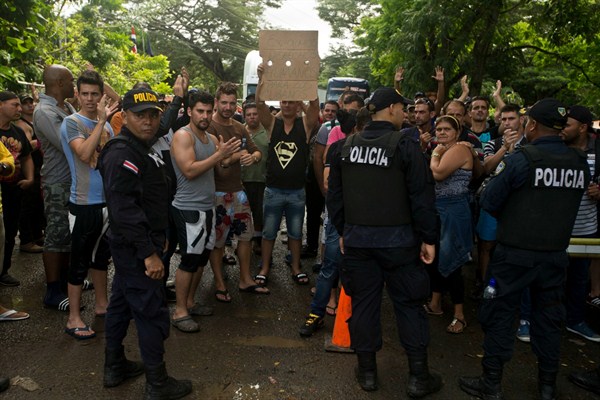Amid the wave of migrants fleeing to the United States from El Salvador, Honduras and Guatemala—collectively referred to as Central America’s Northern Triangle—another migration crisis is unfolding farther south. The Central American isthmus is increasingly becoming a pressure point for migrants from around the world, whether Cubans attempting to reach the U.S.-Mexico border via a circuitous route that begins in Ecuador, or migrants from Africa and South Asia who have been shut out of Europe and look instead to entry points in South America that lead north. The influx is not only straining the resources of countries in southern Central America, but has also raised tensions as neighbors attempt to control their own borders.
The summer of 2014 saw a surge of unaccompanied minors from the Northern Triangle arriving at the U.S.-Mexico border. By August of that year, some 47,017 children from El Salvador, Guatemala and Honduras, as well as Mexico, had been apprehended by U.S. border patrol agents. By the end of the year, total apprehensions reached 68,541, up from 38,759 the year before. While that number fell back to near 2013 levels in 2015, so far this year 54,052 unaccompanied minors had been apprehended as of August. Many of the children, like their adult counterparts, are fleeing violence by gangs, criminal organizations and even the state. While the U.S. government recently agreed to expand a program to grant refugee status to more Central Americans, it was met with questions about whether the policy was too little and too late.
Last year, developments started shifting to southern Central America. Thousands of Cubans were stranded in Costa Rica after authorities there exposed a human-trafficking ring. The Costa Rican government issued transit visas to the Cubans to aid them in their passage to the U.S., where they would be able to apply for asylum. In November 2015, the Nicaraguan government refused to allow thousands of Cuban migrants to cross into Nicaragua from Costa Rica, deploying its armed forces to close its southern border. While complaining bitterly about Nicaragua’s border closure, Costa Rica closed its southern border with Panama in an effort to stem the flow of Cuban migrants. Between 7,000 and 8,000 Cubans remained in Costa Rica while governments in the region worked toward a solution, which included flying Cubans from Costa Rica to El Salvador and then organizing for them to travel to Guatemala by bus in order to bypass Nicaragua. The Cubans would still have to navigate the perilous journey through Mexico to the U.S. border.

